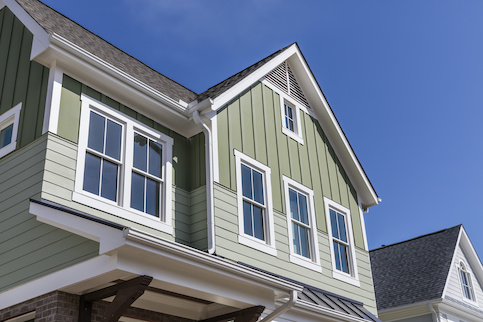Choosing to refinance your mortgage can be a helpful way to achieve your long-term financial and personal goals. Homeowners frequently reach a moment when they decide to pursue a refinance. But why would a homeowner decide to refinance their home, and when is the best time to consider this strategy?
Let’s explore the top reasons to refinance a home loan – and the not-so-great reasons – to help you decide whether refinancing is the best option for your situation.
The 5 Best Reasons To Refinance Your Mortgage
When you refinance a home loan, you replace your existing mortgage with a new one that typically has new loan terms. With new terms, your mortgage can become more manageable or save you money in the long run.
Homeowners consider refinancing for many reasons. Up next are the five most common reasons to refinance.
1. To Lower Your Mortgage Interest Rate
If rates are lower since a borrower initially took out their home loan, they may want to refinance their mortgage to take advantage of low interest rates. Your interest rate impacts the size of your monthly mortgage payment and how much you pay throughout your loan term. The higher your rate, the bigger your monthly payment will be – and the more you’ll shell out in interest.
Refinancing to a lower mortgage rate can decrease your monthly payment, help you save money long term and help you build home equity faster. Your equity grows as you pay down the principal balance of your mortgage. When you pay more toward principal every month because you no longer pay as much interest, you’re building the equity in your home more quickly.
2. To Change Your Loan Term
Borrowers may be able to pay off their mortgage faster without drastically changing their monthly payment if interest rates are very low when refinancing to a shorter loan term.
Even if this scenario isn’t the case, a borrower may want to refinance just to change the length of time they have to pay off their loan. Let’s see what happens when you shorten or lengthen your mortgage term.
Shorten The Loan Term
Refinancing to a mortgage with a shorter term – like switching from a 30-year mortgage to a 15-year mortgage – can help you pay off your mortgage early. You’ll own your house sooner, and an early payoff may free up funds for other financial goals. Choosing a shorter loan term can also help you save money on the interest you pay over the life of the loan.
However, switching to a shorter-term loan typically increases your monthly payment amount. If you’re struggling to make your mortgage payments, consider whether you can realistically handle higher payments with a shorter loan term.
Lengthen The Loan Term
You may choose to refinance to a mortgage with a longer term to lower your monthly mortgage payments. Lengthening your loan term reduces how much money you pay each month because you’re extending the amount of time you have to pay back the loan. Lower monthly payments can also free up funds in your budget to pay off other debts, build up your savings account or invest.
While your monthly payments will be lower, you’ll pay more in total interest over time, and it will take longer to own your property outright.
However, if you’re dealing with a personal or financial challenge that’s making on-time mortgage payments difficult, it’s usually better to be proactive about addressing the issue to avoid foreclosure.
3. To Access Your Home Equity
Refinancing with a cash-out refinance allows you to tap into the equity you’ve built in your home. Equity is your home’s current market value minus how much you owe on your mortgage.
A cash-out refinance replaces your current mortgage with a new and larger loan, providing access to a lump sum of cash by tapping into a portion of your home equity. Homeowners commonly use the money to pay off debt, pay for home improvements or college, build retirement nest eggs, grow a savings fund or invest in the stock market.
4. To Switch Mortgage Types
With a refinance, you can switch from one type of mortgage to another. Let’s say you took out an adjustable-rate mortgage (ARM) when you bought your home.
ARMs can be attractive to borrowers because they offer a relatively low introductory interest rate that can save you money on your monthly payments upfront. Once that introductory period is over, your mortgage interest rate will likely rise and continue to readjust over the remaining loan term. These rate fluctuations are unpredictable and can lead to higher mortgage payments.
With a refinance, you can switch from an ARM to a more predictable fixed-rate mortgage.
5. To Eliminate Mortgage Insurance
If you have a conventional mortgage and put down less than 20%, you’re likely paying private mortgage insurance (PMI). If you took out a Federal Housing Administration (FHA) loan, you’re likely paying a mortgage insurance premium (MIP). FHA borrowers typically pay a portion of the MIP when they close on the loan and continue to make payments toward the annual MIP until the loan is paid back.
Homeowners with conventional loans can ask their lender to cancel PMI once they reach 20% equity in the home and have an 80% loan-to-value ratio (LTV). With an FHA loan, you may stop paying MIP after 11 years if you make at least a 10% down payment. Anything under 10% means you’ll have to pay MIP until the loan is paid off.
To get rid of FHA mortgage insurance, you must reach the 20% equity threshold in the home and refinance to a conventional loan. If your home’s value has increased and your LTV ratio is 80% or less, you can potentially cancel PMI using a rate-and-term refinance.
However, these benefits come at a price. You’ll pay additional costs to close on your new mortgage. Always weigh the cost of refinancing with the potential savings from canceling your mortgage insurance.
What’s Your Goal?
Buy A Home
Discover mortgage options that fit your unique financial needs.

Refinance
Refinance your mortgage to have more money for what matters.
Tap Into Equity
Use your home’s equity and unlock cash to achieve your goals.
When Not To Refinance Your Home
There are scenarios when refinancing may not be worth the time, effort or money. It may not make sense if:
- You’re planning on moving soon. If you move before you reach the refinance breakeven point (the time it takes for your savings to equal or outweigh the cost of refinancing), you won’t have enough time to recoup the closing costs and other fees.
- You’re almost done paying off your mortgage. If you’ve already been faithfully making mortgage payments for a very long time, refinancing to a new 30-year loan can result in paying more interest and negating your savings from lower monthly payments.
- You have credit issues. It may be hard to qualify for a refinance or secure favorable loan terms if your credit score has dropped since you took out your mortgage.
- You don’t have enough equity. Most lenders require 20% equity to refinance. You’re better off waiting if you haven’t reached that threshold.
- You’re feeling pressured. Just because rates are low and other homeowners are refinancing doesn’t mean you have to. Consider your unique financial situation to determine whether refinancing makes sense for you.
Ready To Refinance?
Get matched with a lender that can help you reach your financial goals.
Factors To Consider Before Refinancing Your House
Before you start the refinancing process, carefully assess your financial situation and consider:
- Current mortgage rates: Interest rates play a big part in determining your monthly payment and how much you pay in interest over the life of a loan. If rates are low and you want to refinance to get a better rate and more favorable loan terms, compare lenders to find the most attractive rate and terms.
- Refinance costs: Refinancing a mortgage typically involves closing costs that range from 2% to 6% of the total loan amount. Weigh your closing costs and potential long-term savings to determine whether refinancing makes sense.
- Refinance requirements: You must meet a lender’s requirements to refinance your mortgage, including minimum LTV ratio, debt-to-income ratio, credit score and down payment requirements.
You don’t have to decide whether or not to refinance on your own. Consider talking to a financial adviser or mortgage professional and relying on their expertise.
View Your Refinancing Options
Find a refinance lender that will work with your unique financial situation.
The Bottom Line: Refinancing Can Be Beneficial Under The Right Circumstances
Refinancing your mortgage can help secure a lower interest rate and monthly payments. You can also refinance to tap into the equity you’ve built in your home.
But before you opt to refinance, consider current interest rates, how much it will cost to refinance and whether you meet lender requirements.

Victoria Araj
Victoria Araj is a Staff Writer for Rocket Companies who has held roles in mortgage banking, public relations and more in her 15-plus years of experience. She has a bachelor’s degree in journalism with an emphasis in political science from Michigan State University, and a master’s degree in public administration from the University of Michigan.












